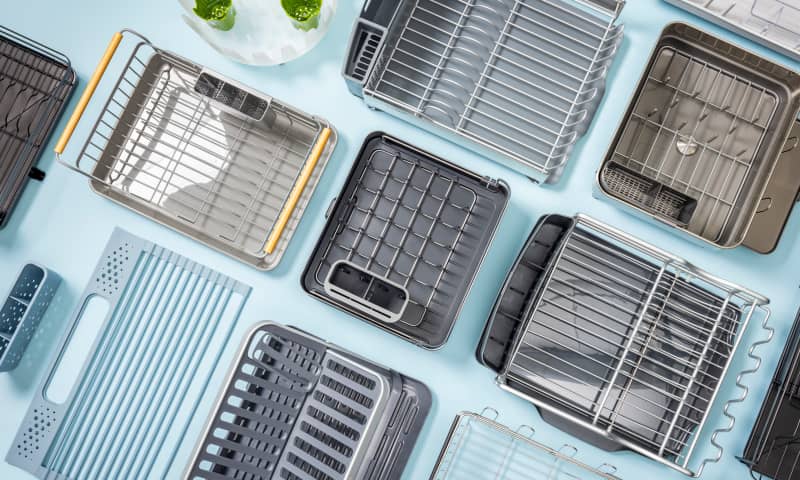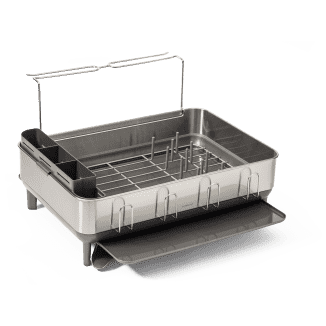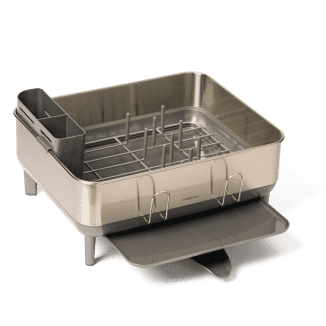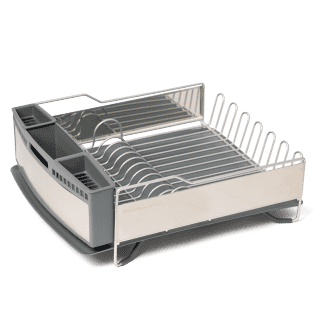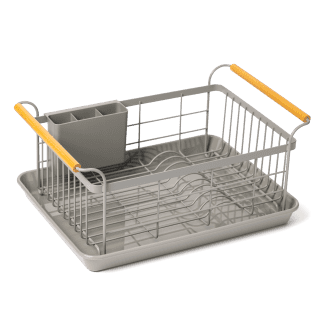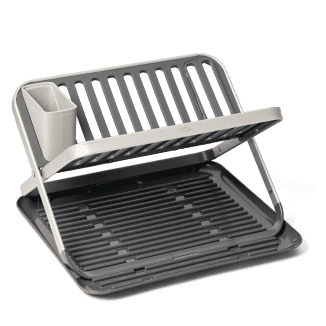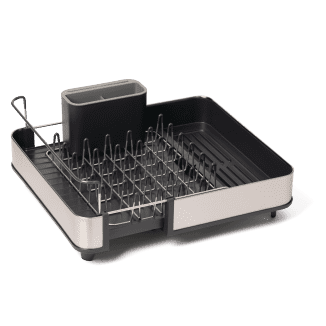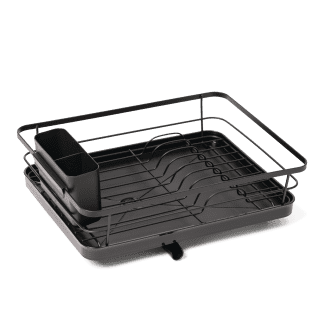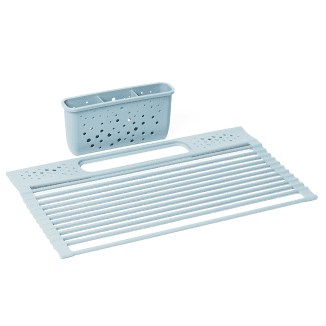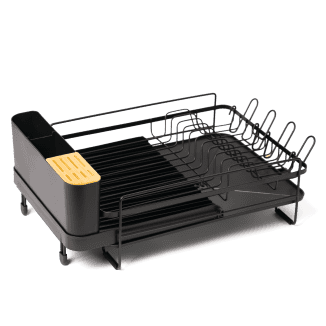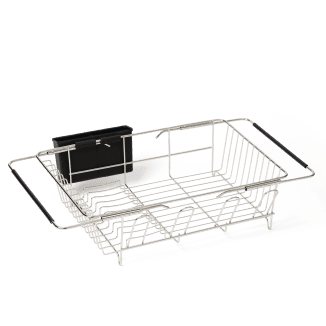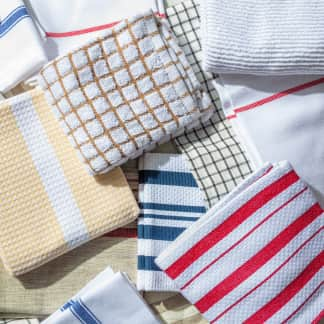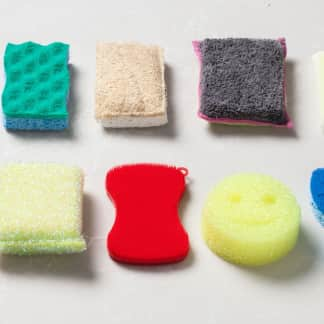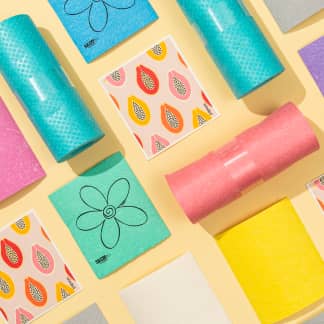We liked sturdily built dish racks that were spacious enough to hold lots of dishes and cookware. Our favorite racks sat stably on the counter, were simple to load and unload, and allowed water to drain and air to flow so that dishes dried quickly. The impressive performance and upgraded features of the Simplehuman Standard Steel Frame Dishrack won it our Best Full-Size Dish Rack designation. The less costly KitchenAid Large Capacity Full Size Rust Resistant Dish Rack performed almost as well but had fewer useful add-ons; we’ve named it our Best Buy. For smaller spaces, we recommend our winning compact rack, the Simplehuman Compact Steel Frame Dishrack.

A dish rack gives you a dedicated space to store your clean dishes while they dry. The best dish racks direct water away from dishware and provide enough space between dishes for air to circulate and water to evaporate, helping your kitchenware dry without any additional work on your part.
There are several dish rack styles on the market, each designed with different priorities in mind. Some racks sit beside a sink, collecting and directing water runoff into the sink basin. Some racks straddle sinks and take up no counter space, while others contain water in a drip tray. There are also collapsible racks that can be out when you need them and stowed when you don’t.
The Different Styles of Dish Racks




A full-size dish rack can hold a day’s worth of dishes for a family of four. Compact racks better serve smaller households and smaller spaces. Expandable models promise the best of both worlds: They have small footprints most of the time but can be extended when you need more drying space.
We tested a lineup of all of these types, looking for full-size and compact options that were effective, easy to use, and durable. We limited our lineup to models made from metal and plastic, avoiding those made of wood: Though attractive, wood can absorb water and split, crack, warp, or mold more easily than metal and plastic, making it a poor material for dish racks.
What to Look For
- Spacious (and Space-Efficient) Designs: Top-performing models were large enough to fit lots of dishes with enough space between items for air to circulate. The best racks also used their space efficiently, positioning cup perches or utensil holders in areas that didn’t block larger items and having ample open space for us to configure dishes however we wanted.



We preferred models designed to hold a lot of dishes in an organized, space-efficient way (left). Poorly designed racks caused dishes and cookware to be cramped and dry more slowly (center) or didn’t hold more than a few dishes at once (right).
- Sturdy Materials: Racks made of heavy-duty metal and plastic were more durable, holding up better under the weight of heavy cookware without bending. These materials also added heft, which helped racks remain stable on our counters.
- Effective Drainage: Our favorite racks managed water well, either by holding dishes above the pooled runoff or using angled trays and spouts to direct as much water as possible into the sink. Top-performing models had drip trays that extended beyond the sides of the racks, allowing them to catch water from cookware that jutted out. We also prized racks with drainage spouts that swiveled 360 degrees, which we could reposition to work in any orientation on either side of the sink.


We liked models that collected water effectively and either drained it efficiently into a sink (left) or held dishes suspended well above their drip trays to keep everything dry (right).
- Well-Designed Dish Supports: Most dish racks use combinations of metal or plastic slots, pegs, and U-shaped perches to organize dishes and cups. We liked it best when these features were widely spaced, which made it easier to fit dishes of varying sizes while maximizing airflow. We also preferred these supports to be tall, straight, and rigid, all of which held dishes stable and kept them from tipping.
- High Sides: Racks with tall sides—measuring at least 3 inches high—were also helpful; they contained water well, and we could lean dishes against them without fearing items would fall out.
Nice to Have
- Stemware Storage: One rack included a removable railing that held wine glasses and other stemware upside down to dry. It was a useful addition, though it did take up more space.
- Extra Drip Trays: Additional drip trays that stowed under racks most of the time but could slide out when we needed them were also helpful.
What to Avoid
- Cramped Designs: Smaller racks that didn’t use space efficiently—especially those without enough open space for us to position our dishes the way we wanted—caused dishes to be cramped and thus dry less quickly and thoroughly.
- Flimsy Materials: Lightweight metal and plastic strained under the weight of heavier cookware.
- Poor Drainage: Some racks managed water poorly, allowing it to pool and collect in nooks where it would then have trouble evaporating. A few racks also had no drainboards under cup perches and other areas where dishes extended outward, so water dripped onto our counters.
- Badly Designed Supports: Narrow, angled plate slots made it more difficult to balance dishes. Squat and angled cup perches didn’t adequately support our glassware, occasionally causing them to tip over.

- Low Sides: Some racks, including the extendable models, had sides shorter than 3 inches high, which had trouble buttressing taller dishes and cookware and containing water. A few models’ removable drip trays were also low-sided, which occasionally caused water to spill.
Other Considerations
- Height: Dish racks with tall legs and higher sides usually worked best but were harder to fit under some kitchen cabinets, especially when filled with large cookware. If you plan to keep your dish rack under your cabinets, measure your space first and choose a higher-ranked product from our charts with dimensions that will fit.
- Drainage versus Evaporation: A few dish racks weren’t designed to drain into the sink, but they had drip trays that collected water and allowed it to evaporate. Some racks had spouts that we could open and close depending on whether there was a nearby sink for drainage. While all our winners are designed to drain into the sink, we do recommend a few models with drip trays or closeable spouts if you’d prefer sink-optional designs.


Some racks, including all of our winners, drained directly into the sink. If you’d prefer a drip tray, we do recommend a few models designed with trays that worked well in our chart below.
- Collapsible Dish Racks: Some racks in our lineup are designed to fold up for easy storage. None of these models performed well enough for us to highly recommend them, but if space is your ultimate concern, we did like a few collapsible racks enough to rank them as recommended.
- Over-the-Sink Racks: Dish racks that rest on the sides of sinks and straddle the sink basin are a clever and useful idea, but the models we tested in this style were either too small or poorly built and spindly for us to recommend them. If you’re short on space, consider a compact or collapsible rack.
The Tests
- Assemble dish racks
- Attempt to fit and dry enough dishes and cookware for a household of four people (for full-size racks) or two people (for compact racks), including plates, mugs, water glasses, stemmed wine glasses, flatware, a 12-inch skillet, a 4-quart saucepan, a quarter-sheet pan, a 10 by 12-inch plastic cutting board, a wooden spoon, a vegetable peeler, and two spatulas
- Attempt to fit and dry bulky kitchen items, including a disassembled salad spinner, a colander, a coffee carafe, and a 12-inch skillet with a lid
- Pour 2 cups of water into empty racks, approximating an accidental spill from the sink, noting any overflows
- Cover dish racks in moistened coffee grounds, set aside, then rinse, noting any stains
- Clean dish racks according to manufacturer’s instructions
- Knock racks off of counter onto floor, noting any damage
- Use each rack at home for several days
How We Rated
- Capacity: We tested whether the dish racks were spacious and space-efficient enough to hold dishes and cookware for households of multiple sizes.
- Performance: We evaluated whether the racks’ designs allowed for good drainage and drying.
- Ease of Use: We assessed how easy the racks were to assemble and clean. We tested how simple it was to load and unload dishes from each model and whether the racks sat stably on the counter.
- Durability: We evaluated the dish racks’ ability to hold up heavy cookware. We also examined whether the racks warped, stained, or rusted from long-term use.
